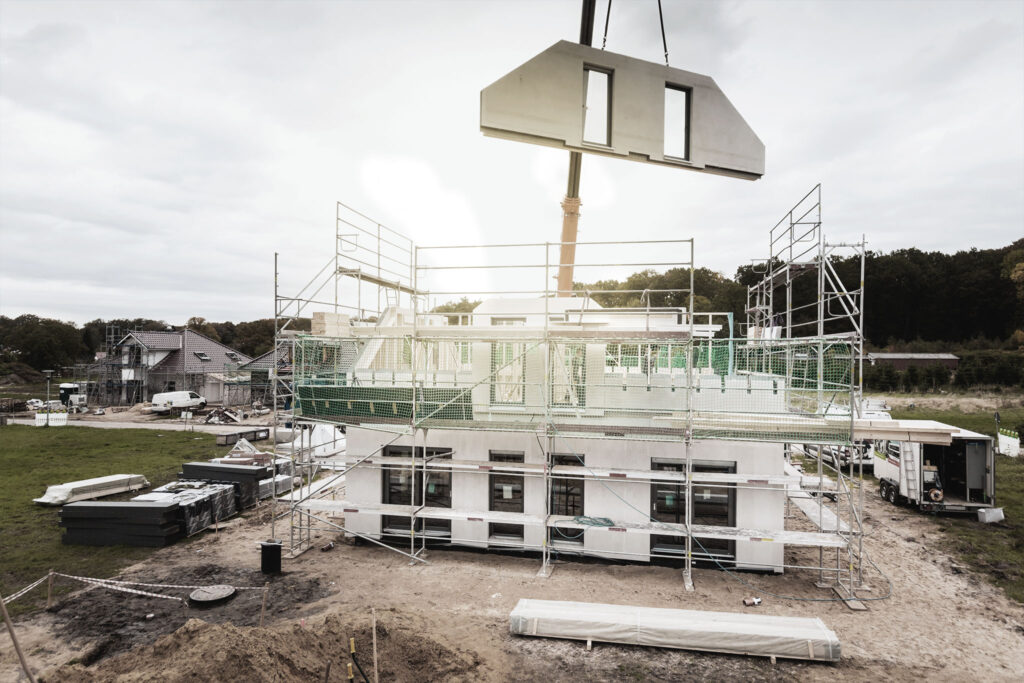Prefabrication and modular construction have gained prominence as powerful strategies for improving construction speed, quality, and sustainability. We’ll explore the latest trends and innovations in prefabrication and modular construction, with a focus on how these methods are driving efficiency and revolutionising the construction industry.
Free eBook: Quick guide to Lean practices for construction professionals
The rise of prefabrication and modular construction
Architects, developers, and other construction professionals are increasingly turning to these innovative methods to enhance efficiency and overcome traditional challenges in their projects.
Prefabrication and modular construction involve assembling building components or entire building sections off-site in a controlled environment before shipping them to the jobsite for assembly. These methods streamline the construction process and offer advantages, including speed, efficiency, sustainability, and design flexibility.
Accelerating project delivery through prefabrication and modular construction
These dynamic construction methods are reshaping traditional project timelines. By shifting a significant part of the construction process off site, it becomes feasible to perform critical activities simultaneously, compressing timelines.
One compelling example is the 10-storey residential building created by the BROAD group in China—the typhoon and earthquake-resistant structure was built in just over a day!
Further reading: Navigating the challenges of regulatory compliance in construction
Prefabrication and modular construction: Catalysts for sustainable building practices
The innovative approaches our industry is taking with prefabrication have led to a trifecta of sustainability benefits:
Reduced waste
Unlike traditional methods that often generate excess materials due to on-site variations, modular construction and prefabrication allow for minimal waste—thanks to components being built in controlled environments with extreme precision. For example, the Mjøstårnet project in Norway used cross-laminated timber panels, minimising waste and demonstrating the efficiency and sustainability of prefabrication.
Energy efficiency
The assembly-line-like production in a controlled factory requires far less energy than typical on-site construction. Just look at the Forest Products Laboratory built in Wisconsin, USA, where crews employed modular construction methods, minimising energy usage and showing how adaptable prefabrication can be in achieving sustainable outcomes.
Eco-friendly building
Modular construction and prefabrication embrace the use of eco-friendly materials, reinforcing their commitment to sustainability. They prioritise materials with lower environmental impact, like recycled steel and sustainably sourced timber. The Bee’ah Headquarters in Sharjah, UAE, shows this with its prefabricated concrete solar panels, exemplifying a fusion of environmental responsibility and innovation.

Revolutionising prefabrication and modular construction with technology
Technological advancements play a vital role in reshaping construction methods, and prefabrication techniques are no different. Once reliant on manual processes, our industry is thriving in the digital age, thanks to cutting-edge tech.
- Building information modelling (BIM)
BIM is a cornerstone in the evolution of construction; it facilitates collaborative planning, designing, and management between stakeholders. This technology means that coordination between designers, architects, manufacturers, and construction teams is seamless. With enhanced visibility and the ability to analyse the entire project in a virtual environment, workflows become smoother as teams can identify and resolve potential issues early on in the project.
- Digital design tools
Whether it’s 3D-modelling tools, parametric design software, or anything in between, digital tools have become indispensable in optimising the efficiency of prefabrication and modular construction—it’s never been easier to precisely plan and customise each component of structures to fit every project’s unique requirements, ensuring prefabricated components fit seamlessly during on-site assembly.
- Robotics and automation
The integration of robotics and automation in manufacturing and assembly processes is a significant leap forward for modular construction. These systems streamline the creation of prefabricated components, enhancing efficiency and precision. For example, the FBR Hadrian X robotic bricklaying system shows how capable automation can be, assembling bricks with unmatched speed and accuracy. Assembly lines utilising these technologies can bring consistent quality, quick production, and cost savings to the entire industry.
More to read: How to upgrade your construction document management with software
Unlocking architectural innovation with prefabrication and modular construction
The evolution of these construction processes isn’t only about efficiency and sustainability—it’s a canvas of design flexibility and customisation, allowing designers, architects, and project owners to bring their visionary concepts to life.
Design flexibility
Prefabrication in construction offers limitless design possibilities, challenging the misconception that modular elements are limited to standardised shapes. Contemporary projects show this, like the LEGO House in Denmark, featuring prefabricated modules forming a structure that resembles stacked LEGO bricks. Playful yet sophisticated, this design showcases the creative freedom afforded by prefabrication.
Design precision
Precision in design is a hallmark of modular construction. The Vitra Campus in Germany exemplifies this precision, featuring various prefabricated buildings created by renowned architects. Each structure shows unique aesthetics and a cohesive design using prefabricated components.
Design functionality
Aesthetics aside, prefabrication and modular construction also meet the functional requirements of unique projects. For example, One Central Park in Sydney, Australia, integrated prefabricated components into its design to create a blend of greenery and modern architecture, highlighting how the method’s customisability contributes to functional efficiency and aesthetic appeal.
Navigating the landscape of prefabrication and modular construction
The benefits of construction prefabrication and modular construction are undeniable; however, successful implementation requires an understanding of the challenges and considerations inherent in these innovative methodologies.
Regulatory compliance is one such challenge—frameworks vary across regions, posing challenges for those employing prefabrication and modular construction. Plus, you have to worry about transportation logistics and consider route optimisation, vehicle capabilities, transportation regulations, etc.
The solution? Construction management software. With LetsBuild, tracking compliance, managing delivery schedules, defining quality standards, and maintaining communication between teams has never been easier.
Unlock the full potential of prefabrication and modular construction and bypass their challenges with your free personalised demo of LetsBuild. It’s time to bring a new era of efficiency, sustainability, and innovation to the industry.




